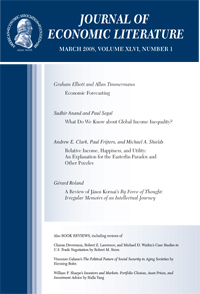Making Our Neighborhoods, Making Our Selves: A Review Essay
IF 11.5
1区 经济学
Q1 ECONOMICS
引用次数: 0
Abstract
This essay reviews Making Our Neighborhoods, Making Our Selves, in which George C. Galster provides an overview of the literatures on neighborhood formation and neighborhood effects. I see two clear ways that Making Our Neighborhoods will serve as a reference strengthening these literatures. Given the state of the literature on neighborhood effects, which is often still at the stage of testing the existence and magnitude of such effects, the author’s framework for classifying the types of heterogeneity we might observe in neighborhood effects will be a valuable tool for researchers. And since the literature on neighborhood formation approaches the issues from a disparate set of fields, the author’s presentation of individual actors shaping neighborhood dynamics while using ideas of equilibrium, belief formation, equity and efficiency, and unpriced externalities should help unify understanding of the economic approach to neighborhood formation. While the author certainly does not shy away from race, I argue that several parts of the presentation would be clearer if they were tied more directly to racial segregation. (JEL D62, D83, I31, J15, R23, R31, Z13)建立我们的邻居,做出我们的选择:一篇评论文章
本文综述了《创造我们的邻居,创造我们的自我》,其中乔治·C·高尔斯特概述了关于邻居形成和邻居效应的文献。我认为《打造我们的邻居》有两种明确的方式可以作为加强这些文献的参考。鉴于邻域效应的文献状况,通常仍处于测试此类效应的存在性和规模的阶段,作者对我们可能在邻域效应中观察到的异质性类型进行分类的框架将是研究人员的一个有价值的工具。由于关于邻里形成的文献是从一组不同的领域来处理问题的,作者在使用平衡、信念形成、公平和效率以及未定价的外部性的思想的同时,对塑造邻里动态的个体行动者的介绍应该有助于统一对邻里形成的经济方法的理解。虽然作者当然不会回避种族问题,但我认为,如果演讲的几个部分与种族隔离更直接地联系在一起,就会更清楚。(JEL D62、D83、I31、J15、R23、R31、Z13)
本文章由计算机程序翻译,如有差异,请以英文原文为准。
求助全文
约1分钟内获得全文
求助全文
来源期刊

Journal of Economic Literature
ECONOMICS-
CiteScore
17.80
自引率
0.80%
发文量
49
期刊介绍:
Commencing in 1969, the Journal of Economic Literature (JEL) serves as a vital resource for economists, offering a means to stay informed about the extensive literature in the field. Each JEL issue features commissioned, peer-reviewed survey and review articles, book reviews, an annotated bibliography categorizing new books by subject, and an annual index of dissertations from North American universities.
 求助内容:
求助内容: 应助结果提醒方式:
应助结果提醒方式:


